Fermentation is the step of winemaking in which our influence has the biggest impact. Every winemaker's interaction is amplified and has long-reaching consequences on the wine. For that reason, it is important to pick the right vessel for the job. One that will work with you to achieve your artistic vision and bring out the desired flavors in wine. There are dozens of options available on the market, each with their own character. To help you decide, we researched the 7 most popular wine fermenter types in the world. Continue reading this article to learn their strengths, flaws, as well as their effect on the winemaking process.
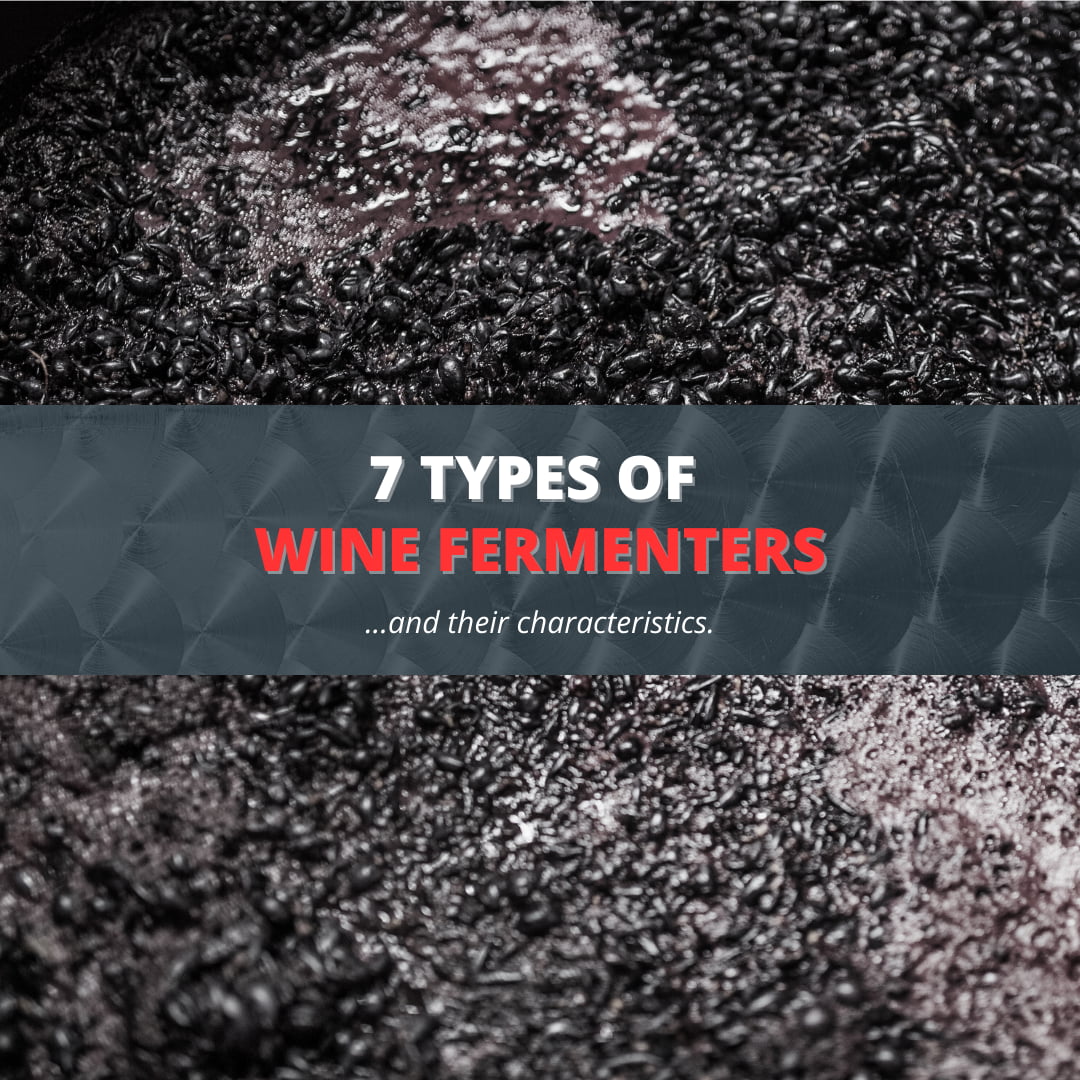
There are a couple of major points to consider before choosing a wine fermenter. The most important one is the sort of wine you'll be making - white, red or rose. This will steer you either toward open top fermenters for red wine, or closed top (sealed) fermenters for white wine and rose.
Another is how much of the grape character and aroma you want to keep. If you want to preserve the fruity flavor, you should look towards inert fermenters.
Some other things you should keep in mind are economics, reliability, and maintenance.
We're opening the list with a winemaker essential - the carboy. Also known as a demijohn, a carboy is a glass vessel with a large body and a narrow neck. They come in various sizes, ranging from 4 to 60 L (1 to 16 US gal). Larger carboys are reinforced with wicker and have handles for easier handling.
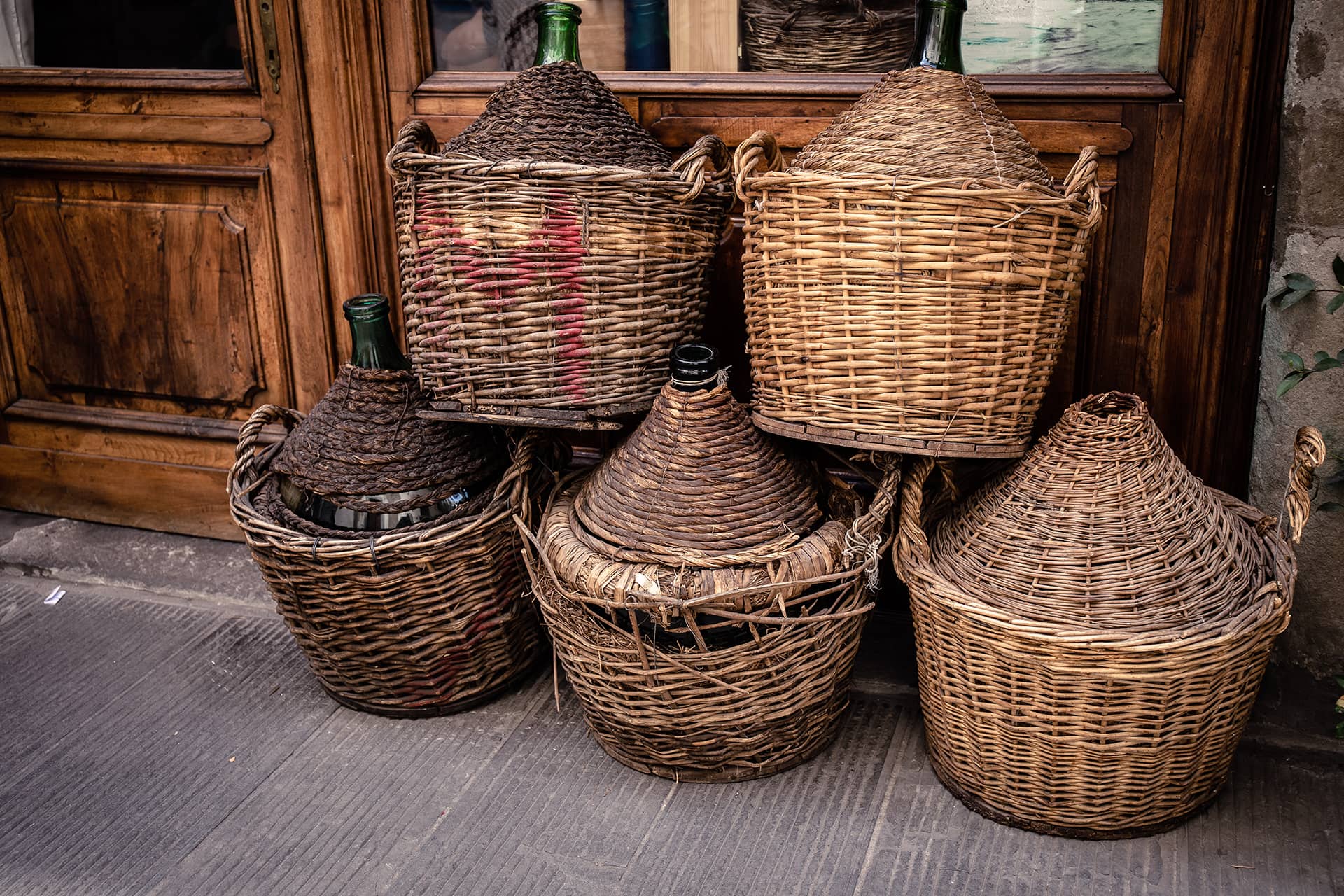

Old demijohns reinforced with wicker.
Even though most wineries use them for storage and transportation, they make good primary fermenters. Glass is a great material because it is inert, giving the winemaker more control over the process. It is also relatively easy to clean, thanks to its smooth surface. You can insert a fermentation lock or a rubber stopper into a carboy to prevent oxygenation. Their smaller size means you can easily put them in a fridge for temperature control. The drawbacks are that they shatter on impact, let light through, and have limited volume.
Carboys make great vessels for white wine fermentation and rosé production. Their narrow necks make them unsuitable for red wine fermentation. If you're a hobby winemaker, or just producing smaller batch wines, you should definitely look into using carboys and demijohns. They are a simple and inexpensive solution.
Food-grade plastic open-top vessels are all grouped here. They can range anywhere from 20 L (5 US gal) for the simplest bucket, to 167 L (44 US gal) for a food-grade trash can. Some winemakers even decide to ferment their wines in large half-ton picking bins.
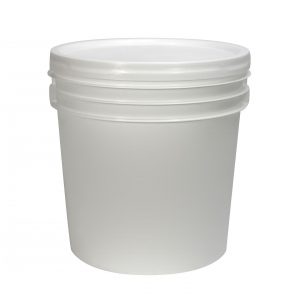

A food-grade plastic bucket.
Plastic fermenters are an inexpensive, and lightweight choice. You'll just have to make sure it is BPA-free and food-grade plastic. Plastic scratches easily, so you'll have to be careful while cleaning the fermenter. Another thing you should consider is bacterial spoilage. Too much oxygen exposure can introduce spoilage organisms to the fermenting must.
Thanks to the various shapes and sizes they come in, plastic fermenters are suitable both for hobbyists and professional winemakers. The wide-open top makes it easy to reach and punch down the pomace cap, making plastic fermenters good for red wine fermentation. Some buckets come with a lid and fermentation lock, allowing you to ferment both red and white wines in the same vessel. If you're looking for a versatile fermenter but can't afford more expensive solutions, consider looking into plastic buckets and bins.
Praised for their aging properties, oak barrels are present in most of the wineries around the world. What they do to young wines during the period of élevage is nothing short of amazing. The porous nature of wood lets molecules of air in, resulting in micro-oxygenation. At the same time, some of the juice evaporates, resulting in wine concentration. Depending on the type of wood (oak) and level of treatment, it imparts some of its character to the wine.
As you can imagine, oak barrels are incredible at aging and malolactic fermentation. But, how do they perform at alcoholic fermentation?
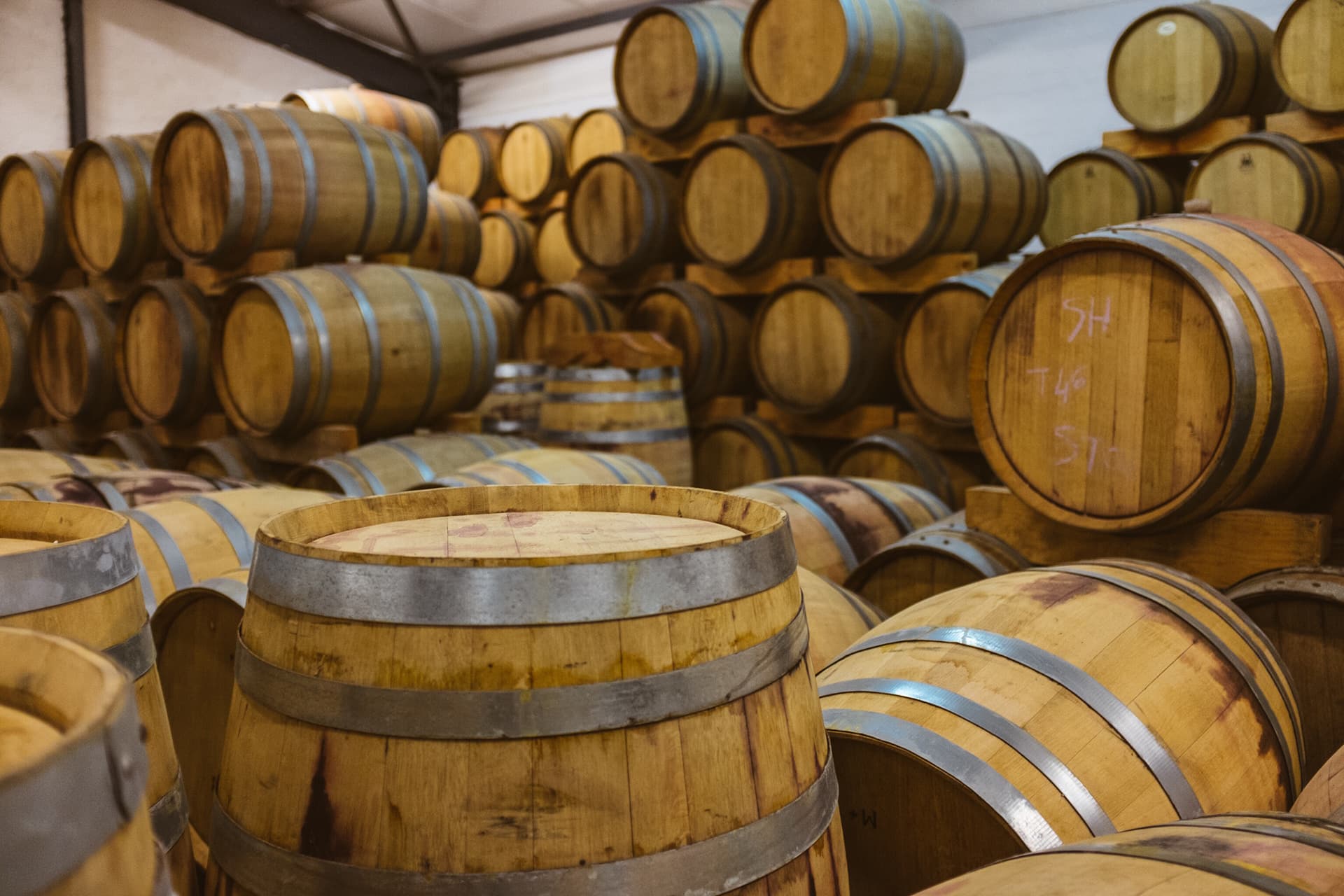

Stacks of oak wine barrels.
Without serious modification, it's impossible to use wood barrels for the primary fermentation of red wine. You would need to remove the head to gain access to the cap. That would render them useless for storage and strip them of their aging properties. Aside from that, oak barrels lose their character within 2-4 cycles. At that point, you could have them re-coopered, or buy new ones and modify them again. That makes them a poor, high-maintenance choice for the red wine fermentation process.
When it comes to white wine fermentation, the story is a bit different. Since there is no need for cap management, you can use oak barrels for fermenting white wines as-is. Just keep in mind barrels usually ferment at higher temperatures, so the juice ferments more quickly. The small volume of the fermentation vessel also helps them settle. Since barrels do not have cooling jackets it is best to chill the juice the night before filling.
Maintaining (oak) barrels is quite a hassle. The same porous nature of wood that gives them great aging properties makes them difficult to clean and keep sanitary. When barrels are dry, there is a constant danger of microbial contamination and mold growth. You'll have to burn sulfur wicks periodically to reduce the risk of contamination.
Keep in mind wood retains pigments, and you risk color carry-over if you use the same barrel for both red and white wines.
All things considered, oak barrels are niche wine fermenters. They're good for fermenting a grape variety like Chardonnay and other whites which could use the oaky sensory properties. If that's not the case, you should consider looking into other fermentation vessels. After all, the strength of oak barrels lies in secondary fermentation and aging.
Stainless steel tanks are the most popular type of vessel for winemaking. They first started appearing in the 1950s and took the wine world by storm. You'll be hard-pressed to find a winery that doesn't use them in their winemaking process today.
There are two main categories of stainless steel tanks: closed top tanks and open top tanks. Closed top tanks are also known as sealed tanks because they are completely enclosed. Open top tanks are also called variable capacity tanks because they have a "floating" lid. The lid is fixed on the surface of the liquid, moving as the level changes. It can also be removed completely. This enables you to use a single tank for every sort of wine and stage of fermentation, even aging.
Rows of large stainless steel tanks at the Krispel winery in Austria.
Stainless steel tanks can be manufactured in many different ways. You can talk to most wine tank manufacturers and customize the wine fermenter design. For instance, you can adjust the dimensions, shape, valves, and fittings to your liking. Some manufacturers will even accept completely custom designs.
Thanks to its properties, stainless steel and wine are a match made in heaven. Stainless steel is chemically inert and oxygen impermeable. This means that it won't impart any unwanted flavors or aromas. That causes the character of your grapes to be more finely expressed.
If you want even more control over the fermentation process, you can equip the wine tank with a dimpled, glycol cooling jacket. It will allow you to adjust the temperature inside of the fermentation tank. Additionally, the tank can be wrapped with insulating foam to help with thermal efficiency.
Stainless steel wine fermenters at the Möet & Chandon winery in France.
When it comes to maintenance, there is no other wine fermenter you'd rather have. Stainless steel isn't porous by nature, and there are no cracks the bacteria can hide in. That means you won't have to sanitize them that often. Cleaning them is a breeze, thanks to their polished interior and rounded corners. A simple hose-down will do most of the work.
Stainless steel tanks are surprisingly light for their size. When empty, smaller fermenters can be easily handled by a single person. Some models even come equipped with wheels and forklift skirts, providing unmatched mobility.
There are several reasons why stainless steel tanks are a global phenomenon. They are extremely durable, reliable, and easy to maintain. When it comes to economics, their price per gallon and expected life span are impossible to beat. Unlike other options, they'll last you for decades. Well-maintained tanks keep a good resell value even if they're several years old. Additionally, they offer an unprecedented level of control of the fermentation process. And to top it all off, stainless steel tanks are the most versatile fermentation vessel. If you're serious about winemaking, nothing beats a stainless steel fermenter.
Somewhere between stainless steel fermenters and oak barrels lie wood tanks. They are available in closed and open top variants and can be equipped with stainless steel accessories.
They are shaped like their stainless steel cousin - tall and cylindrical. The difference is, instead of a stainless steel coat, they are lined with tall lumber (oak) staves.
Their size makes them more economical, keeping the price per gallon lower. They are also quite durable, often lasting for decades if properly maintained.
You'll get most of the important benefits of oak barrels, without the hassle of having to modify them. Just keep in mind that oak will still lose its character-giving properties within 2-4 cycles of use. After that, you'll have to use oak adjunctives.
The shape is also different from oak barrels, with a much larger surface area. That means the fermentation performance won't be the same across the two tanks.
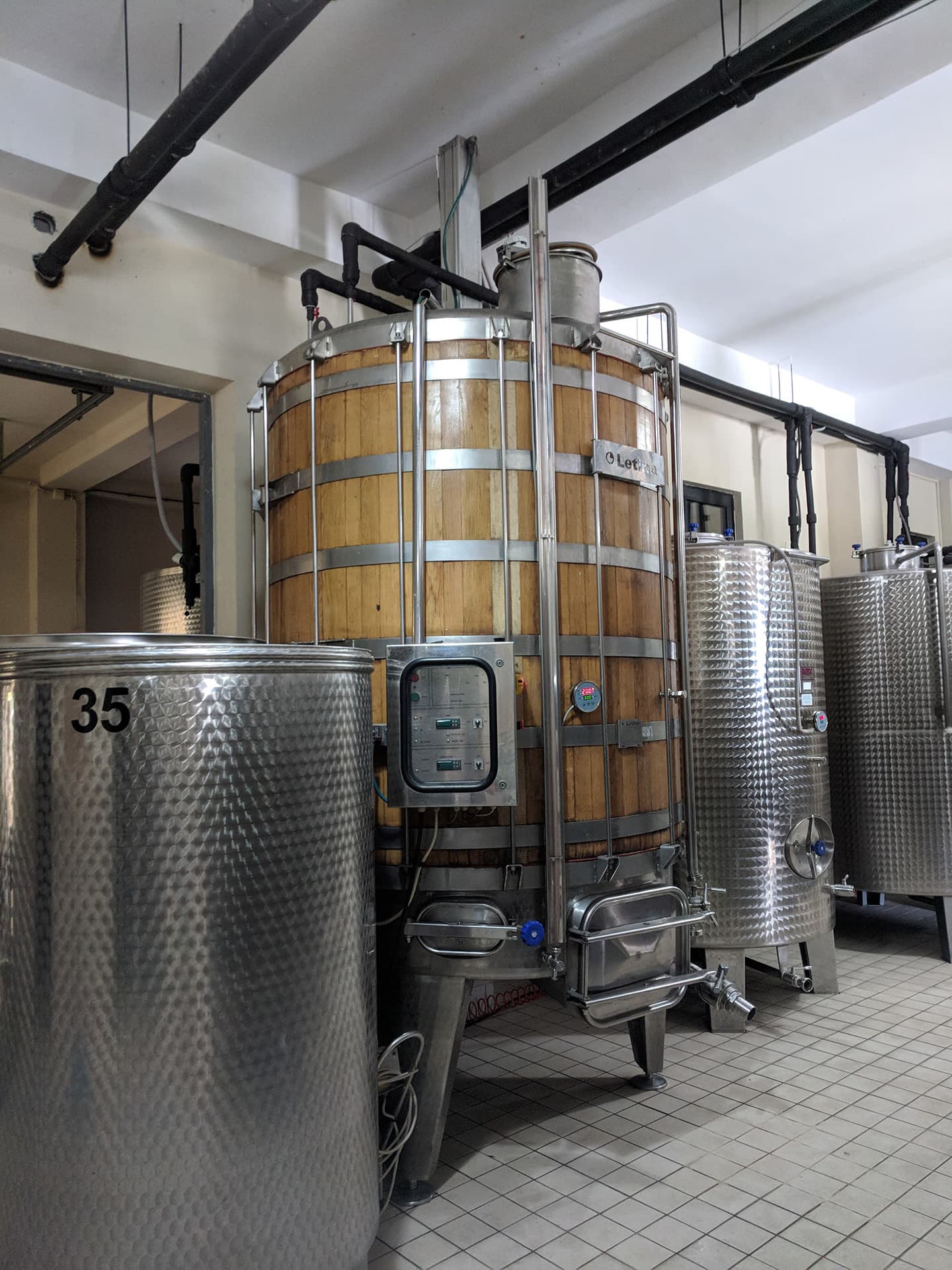

Wooden wine fermenter.
Like with wood barrels, these fermenters require quite a bit of maintenance. Sanitization is difficult because of the porous nature of wood. Before (dry) storing them, you will have to hydrate the wood to prevent it from drying out.
Keep in mind wood retains pigments, and you risk color carry-over if you use the same tank for both red and white wines.
If you want access to all of the beneficial properties of oak during primary fermentation, but don't want the hassle of modifying barrels, wood tanks are a sensible choice. Otherwise, stainless steel tanks are a much better choice.
Before the stainless steel era, concrete tanks were the most common type of fermenter in a winery. Mostly forgotten for the past 50 years, concrete tanks are starting to make a comeback.
A great advantage of concrete tanks is their ability to be cast into almost any shape imaginable. From the more standard, space-saving cubes, to large egg-shaped fermenters, winemakers are taking advantage of the mouldability of concrete.


Egg-shaped concrete fermenter.
No matter which shape you choose, concrete acts as a temperature stabilizer. It will cool during hot days, and warm during cold nights.
This results in a much more gradual fermentation rate.
Concrete tanks are often portrayed as a more inert counterpart to oak barrels. The micropores in concrete allow oxygenation and concentration to occur, just like with oak barrels. On the other hand, concrete doesn't have such an overwhelming character. The terroir and aroma of grapes are more pronounced.
Concrete is not completely chemically inert, though. The acids in wine react with concrete, releasing metal compounds into the wine. That is why wines fermented in concrete tanks have hints of a metallic taste to them.
Since the micropores are a perfect breeding ground for bacteria, you will have to sanitize the tank often. Unlike other tanks, you won't be able to move them to a cleaning station. They will have to be cleaned in place.
Another thing worth considering is pigment retention. You don't want to use the same concrete tank for both red and white wine fermentations, else you risk color carry-over.
If the formulation is good, concrete fermenters can last for decades before cracking and leaking. Their longevity is important, as moving them can prove to be quite challenging.
When it comes to price, concrete tanks are on the higher end. Combined with the fact their resell value is low, they aren't the most economical choice.
Concrete fermenters are a good choice for experienced winemakers with a larger budget. If you believe your wines won't benefit from the slightly metallic taste, you should consider another fermenter type.
Clay pots are the oldest known wine fermentation vessel. They were used by almost every ancient civilization, including Greeks, Romans, Egyptians, Canaanites... Spurred by the desire to make wines as natural as possible, winemakers all over the world are once more turning to fermentation in pottery.
Like wood in oak barrels, clay is porous, letting in a tiny amount of oxygen. It also lets a small amount of the stored liquid evaporate, resulting in a more concentrated wine. As a result, the wine develops a deep and rich texture. Unlike oak, clay is more neutral - it won't impart any additional flavors. This lets the wine express terroir more freely.
The thick clay provides natural insulation. Much like concrete, it stabilizes the temperatures inside of the vessel. The temperature during primary fermentation peaks at around 22 °C. As a result, the process lasts around 3 times longer than barrel fermentation. This cool, slow fermentation process produces brighter and fresher wines. The stable temperature also aids in malolactic fermentation for a more buttery flavor.
It is said that clay fermenters are naturally stable - they don't need stabilizing agents or clarification chemicals. Silicon crystals in the walls help remove tartrates.
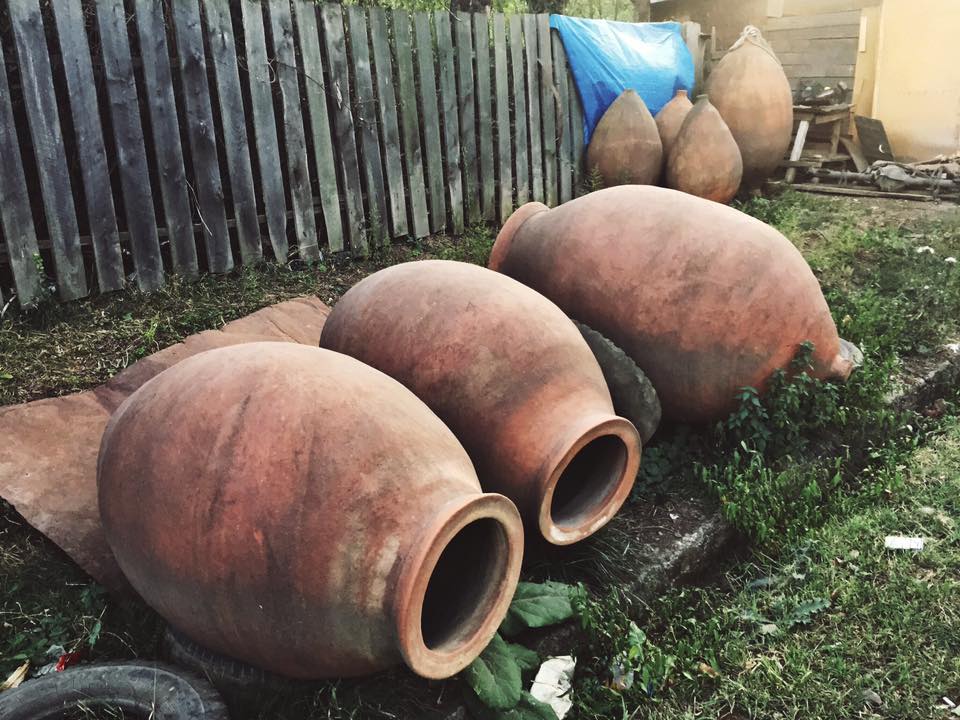

Georgian Kvevri.
Clay vessels come in various shapes - most popular being the Georgian "Qvevri". Kvevri are traditional Georgian vinification vessels continually used for over 8000 years. They resemble a teardrop - an egg-shaped belly with a conical bottom. This lets the lees settle in the bottom, reducing the bitter tannins. The result is less acidity in the finished wine.
These terracotta fermenters aren't more widely adopted because they're very labor-intensive. Winemakers estimate they could fill as much as 10 times more bottles using modern, stainless steel equipment. You will also have to be careful during sanitization. The pores in clay are home to many micro-organisms, yet you can't use hot water to rinse the vessel. The clay might crack.
They will also prove difficult to source, as they're hard to manufacture. It requires a skilled craftsman, and even if you find one, the pots are limited to a lower volume than stainless or wood tanks. This makes clay fermenters very expensive.
Clay pots are recommended for winemakers looking to go back to the roots, focused on organic and natural production. Before buying one, make sure you keep in mind the added labor involved.
As it is with every decision in the winemaking process, picking the right fermenter is not an easy choice.
While there are plenty of fermentation vessels to choose from, there is no single best option. Each of these wine fermenter types has its advantages and disadvantages. You will have to find your own mix of versatility, durability, and fermentation control.
In the end, the decision comes down to the wine flavors you wish to accentuate.
There are several things that make stainless steel tanks the best wine fermenter. Stainless steel is inert and oxygen impermeable. The tanks can be equipped with cooling jackets and insulation for an even greater level of control of the fermentation process.
If you opt for a variable volume model, you can use it for both red and white wine fermentation, and even aging. Some manufacturers will adjust the shape, taper, and valve and door locations to your liking.
Stainless steel wine fermenters are very cost-effective. Depending on their size, their cost-per-gallon can be pretty low. Unlike other options, they'll last you for decades. Well-maintained tanks keep a good resell value even if they're several years old.
Maintaining stainless steel fermenters is simple - just keep them clean. Sanitizing them is much easier thanks to their polished interior and rounded corners. Stainless steel isn't porous by nature, so you won't have to worry about bacteria hiding in tiny cracks. When empty, stainless fermenters are lightweight and easily handled by a single person. Some come equipped with wheels or forklift skirts, making moving them around a breeze.
All that makes stainless steel fermenters a great choice for professional winemakers.
Depending on how passionate you are, and how much you can set aside, there are 3 potential answers to that question: